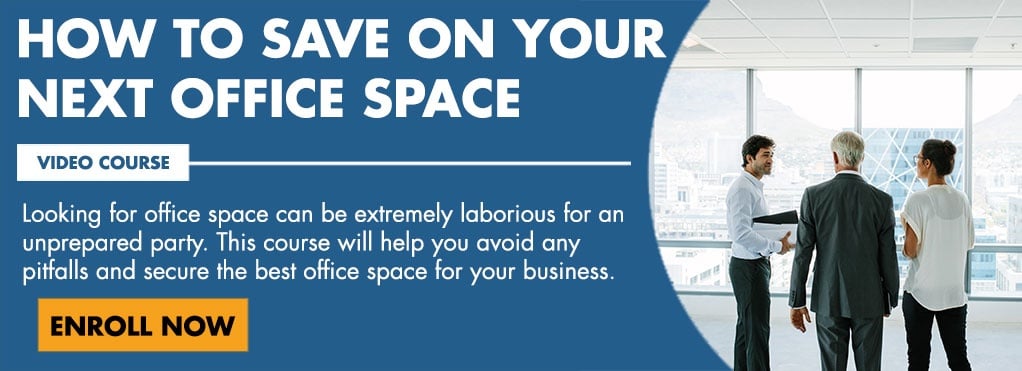At this stage of your property search, you probably don’t need to be reminded of how critical it is to determine your needs for commercial real estate properly. Been there, done that.
Now, what you need to know (and fast) is how to get the most out of your opportunity to tour the possible contenders. Due diligence when touring is key to ensuring that your prospective office is everything it was promised. So, prepare yourself with this checklist for finding office space. It will serve you with the key considerations that will increase the likelihood of your touring success.
1. You've Vetted the Property in a Virtual Tour
2. Your Top Team is Visiting Your Top Picks
4. Consider the Property's Initial State
1. You’ve Vetted the Property in a Virtual Tour
Generally, touring is broken into two stages: virtual and in-person tours. Virtual tours are a critical stage of the process. Not only do they allow you to view multiple properties without leaving your office, but they also make sure you don’t waste time with all the properties that aren’t worth your time.
On a time and efficiency scale, it's unreasonable to view the 20-30+ properties you’re likely starting out with. You will make your first cut of the sites following the virtual tours. Then, after determining the properties you want to pursue further, you should review the sites in person.
2. Your Top Team is Visiting Your Top Picks
The old saying a picture is worth a thousand words is so true when trying to recollect the details of a site tour. Nowadays, everyone has a smartphone that can take excellent photos. Thereafter, they are easy to then call up and easy to share. So, encourage your entourage to use their phones. Modern ones have excellent wide-angle lens too. That can be very useful.
Also, panoramic and video are great to take while on tour. Of course, if you are using a Tenant Rep, they can save you a lot of time by doing this for you in advance of your tour. That will help you be most time efficient.
Why not use the landlord’s or their broker’s photos? Well, it’s like the photos you see when booking a hotel room. They are only going to be the most complimentary photos, which often is a distorted view of reality. Your Tenant Rep should take photos and/or video that shows a site’s pluses and minus. This is crucial.
3. Note the Location
When visiting properties, you’re getting the invaluable opportunity to check things out. Look at the area... Is it in a good spot? Is it safe? What is around the site? Is there good parking? How about a place to eat and shop?
Recently, ensuring the safety of employees has been more critical than ever. As transit crimes increased 58% in NYC in the last year, this is something you must consider.
It's not just Manhattan; it's many major metropolitan areas. Take for instance, Chicago. The high crime is pushing businesses and professionals away to the suburbs or other states. In fact, it was a central impetus for driving away financial service behemoth Citadel and founder Ken Griffiths,
|
“If people aren’t safe here, they’re not going to live here. I’ve had multiple colleagues mugged at gunpoint. I’ve had a colleague stabbed on the way to work. Countless issues of burglary. I mean, that’s a really difficult backdrop with which to draw talent to your city from." |
Cities that require public transit for commutes may be putting your team in a precarious position. When recruiting and maintaining great talent, know that they're not going to put up with feeling unsafe on the way to work.
How Convenient and Safe is the Commute?
At this stage, you should also consider how accessible your employees' commute is. If you are maintaining your staff, it should be within a reasonable distance of the original office. By this same reasoning, you should also ensure that you are not abandoning your customer base in the new location.
You did the commute yourself... was it easy to get to? Is it accessible by major roads? Are there any prospective roadblocks that could complicate your team members’ commute? These are critical pieces to the puzzle of finding the perfect office space.
If some of your employees are commuting by mass transit, is that safe?
4. Consider the Property’s Initial State
Your tour begins before you enter the building. If there’s parking, what does the lot look like? What's the parking ratio? Are there enough spots- for employees and visitors? Is the state of the lot workable, or will it need significant repairs?

Construction for lots and/or garages can get expensive quickly. So, if there are issues here, make sure you remember them when negotiating your tenant improvement allowance.
Similarly, is the lot or property accessible for handicapped persons? If you’re providing parking- which you likely are for a suburban office- you must include a minimum of one handicapped spot per 25 parking spots. These spots should be within close distance to handicap-accessible entrances.
Upon entering the building, note the property's condition. If it's in its barest condition, a cold dark shell, the space will require significant renovation $$$ (and time) to get in working order. The thing to watch out for with cold dark shells is what extent of the buildout your tenant improvement allowance covers. Your landlord should fund all environment enhancements that will outlive the term of your lease.
If the building is in a warm lit state (getting to this condition should be the bare minimum of your TI) how much more work will it take before your company can move in? Does it have the appropriate fixtures, outlets, lighting, etc.? How may the existing floor-plan increase or potentially decrease productivity?

If you’re visiting a multi-tenant building, what does the lobby look like? How large are the common areas? All these things features influence the building’s property value and prepare you for properly negotiating.
5. The Size of the Space
When considering the size of the space, don’t forget to think about how the overall layout will influence your utilization. How easy will it be to convert the floor plan to one that will work for your company?
Consider how the layout influences your need for space. For example, if you want multiple private offices that allow for the privacy of connecting with remote workers, you may need more space for a fewer number of employees. On the other hand, you may not need as much space as you did in prior leases because it's likely that your employees won’t always be in the office at the same time.
In fact, with the popularity of hybrid schedules, this is likely true.
|
“58% of American workers have the option to work from home at least part of the week.” |
According to McKinsey and Company.
So, consider how this affects how much space you need now and in years to come.
At this stage of finding office space, you probably already know how much space you need, but now you get to check out how the disposition will be in each property.
Rentable vs. Usable Square Feet
It's also at this time that you’ll get a more personal understanding of each building’s load factor (or the difference between the rentable and usable square feet). You also get the chance to measure the property’s features for yourself. Is everything as advertised?
There should be no surprises after a proper tour.
Touring with a Tenant Rep
Touring is important, but it’s only one piece of the puzzle to finding the perfect office space. In order to be ready for everything that comes after, you may need guidance. From making the final cuts, drafting (and redrafting) RFPs to executing the lease for the final selection, a Tenant Rep can be a crucial member of your team. At iOptimize Realty® we are Tenant Reps who act as your ad hoc CRE department.
We have 30+ years of experience only representing tenants. Never landlords. As such, we know all the tricks of the trade that get our clients the best terms, properties, and typically 33% savings. We broke down our market knowledge into 7 steps to find the right office. The course is free and chock full of CRE blessings for tenants. If you want to check it out, enroll now.
If you’re ready to talk to a Tenant Rep yourself now, schedule a meeting today!



